belt GMC ENVOY 1998 Owners Manual
[x] Cancel search | Manufacturer: GMC, Model Year: 1998, Model line: ENVOY, Model: GMC ENVOY 1998Pages: 386, PDF Size: 20.33 MB
Page 2 of 386

The 1998 GMC Envoy Owner’s Manual
1-1
2- 1
3- 1
4- 1
5- 1
6-1
7- 1
8- 1
9-1
Seats and Restraint Systems
This section tells you how to use your seats and safe.ty belts properly. It also explains the “SIR” system.
Features and Controls
This section explains how to start and operate your vehicle.
Comfort Controls and Audio Systems
This section tells you how to adjust the ventilation and comf‘orr controls and how to operate your audio system.
Your Driving and the Road
Here you’ll find helpful information and tips about. the road and how to drive under different conditions.
Problems on the Road
This section tells what to do if you have a problem while driving, such as a flat tire or overheated engine, etc.
Service and Appearance Care
Here the manual tells you how to keep your vehicle running properly and looking good.
Maintenance Schedule
This section tells you when to perform vehicle maintenance and what fluids and lubricants to use.
Customer Assistance Information
This section tells you how to contact GMC for assistance and how to get service and owner publications.
It also gives you information on “Reporting Safety Defects” on page 8- 10.
Index
Heree‘s an alphabetical listing of almost every subject in this manual. You can use it to quickly find
something you want to read.
i
I
ProCarManuals.com
Page 6 of 386
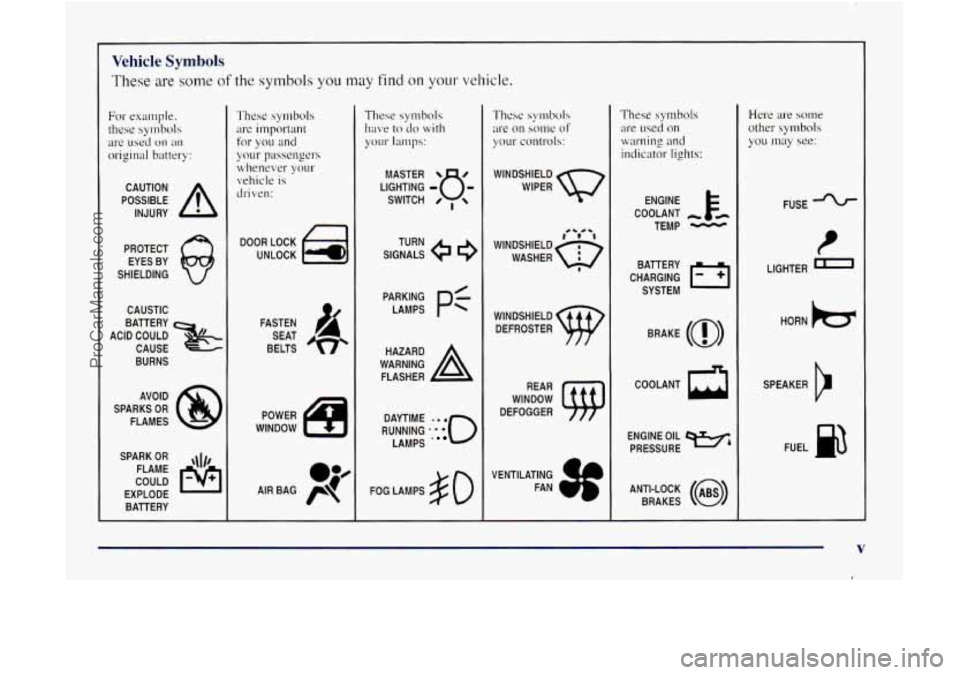
1
Vehicle Symbols
These are some of the symbols you tnay find on your vehicle.
For example.
these symbols
are used
on an
original battery:
POSSIBLE A
CAUTION
INJURY
PROTECT EYES BY
SHIELDING
CAUSTIC
ACID COULD
BATTERY
CAUSE
BURNS
AVOID
SPARKS
OR
FLAMES
SPARK
OR ,111,
COULD FLAME
EXPLODE BATTERY
These symbols
are important
for you and
your passenpel-s
whenever your vehicle
is
driven:
DOOR LOCK
UNLOCK
FA$TEll SEAT
BELTS SIGNALS
TURN
RUNNING
.':**o
DAYTIME LAMPS
*
FOG LAMPS $0
WINDSHIELD
WIPER
WINDSHIELD DEFROSTER
WINDOW
DEFOGGER
VENTILATING
i F,
FAN COOLANT
-
TEMP -
CHARGING I-1
BATTERY
SYSTEM
BRAKE
(a)
COOLANT a
ENGINE OIL w,
PRESSURE
ANTI-LOCK
(@)
BRAKES
Here are some
other symbols
you may see:
FUSE
P
LIGHTER m
HORN b
SPEAKER
b
FUEL p3
V
1
ProCarManuals.com
Page 8 of 386

Section 1 Seats and Restraint Systems
Here you’ll find information about the seats in your vehicle and how to use your safety belts properly. You can also
learn about some things you should nut do with air bags and safety belts.
1-2
1-7
1-11
1-12
1-12
1-19
1-20 1-20
1-28 Seats
and Seat Controls
Safety Belts: They’re for Everyone
Here Are Questions
Many People Ask About
Safety Belts
-- and the Answers
How to Wear Safety Belts Properly
Driver Position
Safety Belt Use During Pregnancy
Right Front Passenger Position
Supplemental Inflatable Restraint
(SIR) System
Rear Seat Passengers 1-3
1
1-34
1-35
1-38
1-49
1-52 1-52
1-53
Rear Safety Belt Comfort Guides for Children
and Small Adults
Center Rear Passenger Position
Children Child Restraints
Larger Children
Safety Belt Extender
Checking Your Restraint Systems
Replacing Restraint System Parts After
a Crash
1-1
ProCarManuals.com
Page 10 of 386

Moving the whole button up or down raises or lowers
the whole seat. Heated Front Seats
Vertical Control: Move the reclining front seatback
rearward by moving the button toward the rear
of the
vehicle. Move the seatback forward by moving the
button toward the front of
the vehicle.
Power Lumbar Control
This control is located on
the side
of the seat. This
feature
will quickly heat the
lower cushion and lower
back of the driver and
front passenger seats for
added comfort.
This control is located on
the side of the seat facing
the door.
Press the lower part
of the switch to turn the heater on
low. Press
the upper part of the switch to turn the heater
on high. Put
the switch in the center position to turn
the heater off. The seatbelt must be latched to activate
this feature.
Press and hold the front
of the control until you have the
desired lumbar support.
To decrease lumbar support,
press and hold the rear
of the control.
1-3
I
ProCarManuals.com
Page 12 of 386
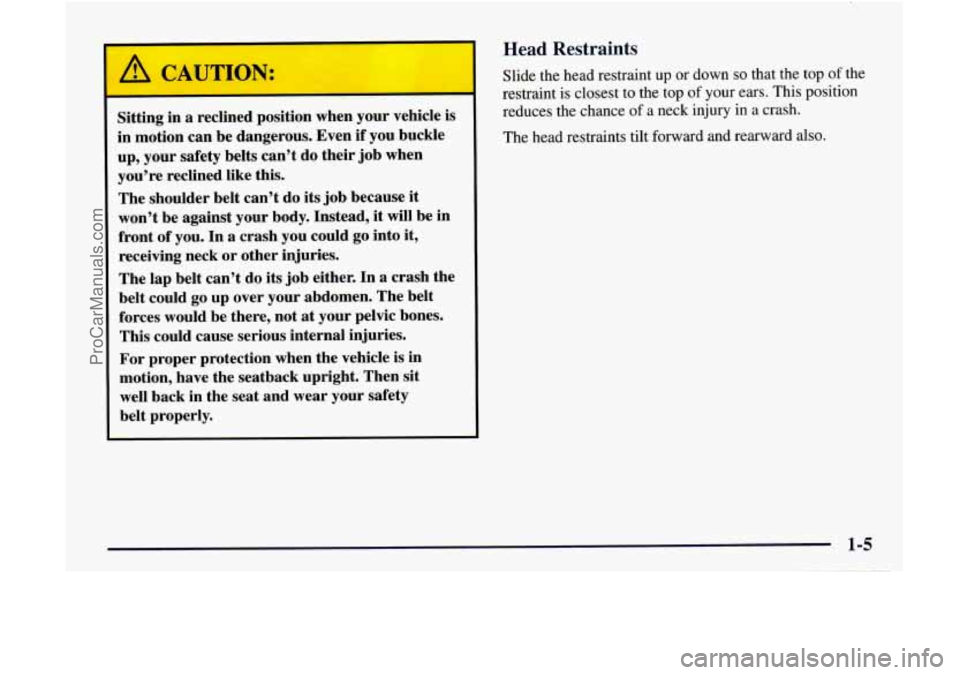
A CAUTION:
Sitting in a reclined position when your vehicle is
in motion can be dangerous. Even if you buckle
up, your safety belts can’t do their job when
you’re reclined like this.
The shoulder belt can’t do its job because it
won’t be against your body. Instead, it will be in
front of you. In a crash you could go into it,
receiving neck or other injuries.
The lap belt can’t do its job either. In a crash the
belt could go up over your abdomen. The belt
forces would be there, not at your pelvic bones.
This could cause serious internal injuries.
For proper protection when the vehicle is in
motion, have the seatback upright. Then sit
well back in the seat and wear your safety
belt properly.
Head Restraints
Slide the head restraint up or down so that the top of the
restraint is closest to the top
of your ears. This position
reduces the chance of a neck injury in a crash.
The head restraints tilt forward and rearward also.
1-5
I
ProCarManuals.com
Page 14 of 386
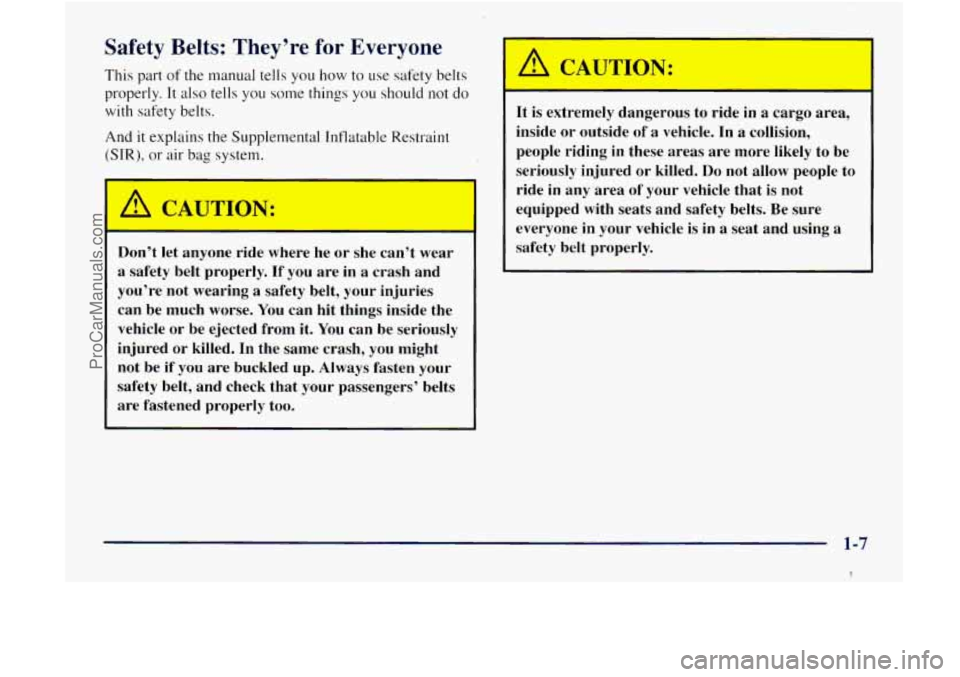
Safety Belts: They’re for Everyone
This part of the manual tells you how to use safety belts
properly.
It also tells you some things you should not do
with safety belts.
And it explains the Supplemental Inflatable Restraint
(SIR), or air bag system.
A CAUTION:
Don’t let anyone ride where he or she can’t wear
a safety belt properly. If you are in a crash and
you’re not wearing a safety belt, your injuries
can be much worse. You can hit things inside the
vehicle or be ejected from it. You can be seriously
injured or killed.
In the same crash, you might
not be if you are buckled up. Always fasten your
safety belt, and check that your passengers’ belts
are fastened properly too.
A CAUTION:
It is extremely dangerous to ride in a cargo area,
inside or outside of a vehicle. In a collision,
people riding in these areas are more likely to be
seriously injured or killed.
Do not allow people to
ride
in any area of your vehicle that is not
equipped with seats and safety belts. Be sure
everyone in your vehicle is
in a seat and using a
, safety belt properly.
I
1-7
1
ProCarManuals.com
Page 15 of 386

Your vehicle has a light that
comes
on as a reminder to
buckle
up. (See “Safety
Belt Reminder Light”
in
the Index.)
In most states and Canadian provinces, the law says to
wear safety belts. Here’s why:
They work.
You never know if you’ll be in a crash. If you do have a
crash, you don’t know
if it will be a bad one.
A few crashes are mild, and some crashes can be so
serious that even buckled up a person wouldn’t survive.
But most crashes are in between. In many
of them,
people who buckle up can survive and sometimes walk
away. Without belts they could have been badly hurt
or killed.
After more than
30 years of safety belts in vehicles, the
facts are clear.
In most crashes buckling up does
matter
... a lot!
Why Safety Belts Work
When you ride in or on anything, you go as fast as
it goes.
I
Take the simplest vehicle. Suppose it’s just a seat
on wheels.
1-8
ProCarManuals.com
Page 18 of 386
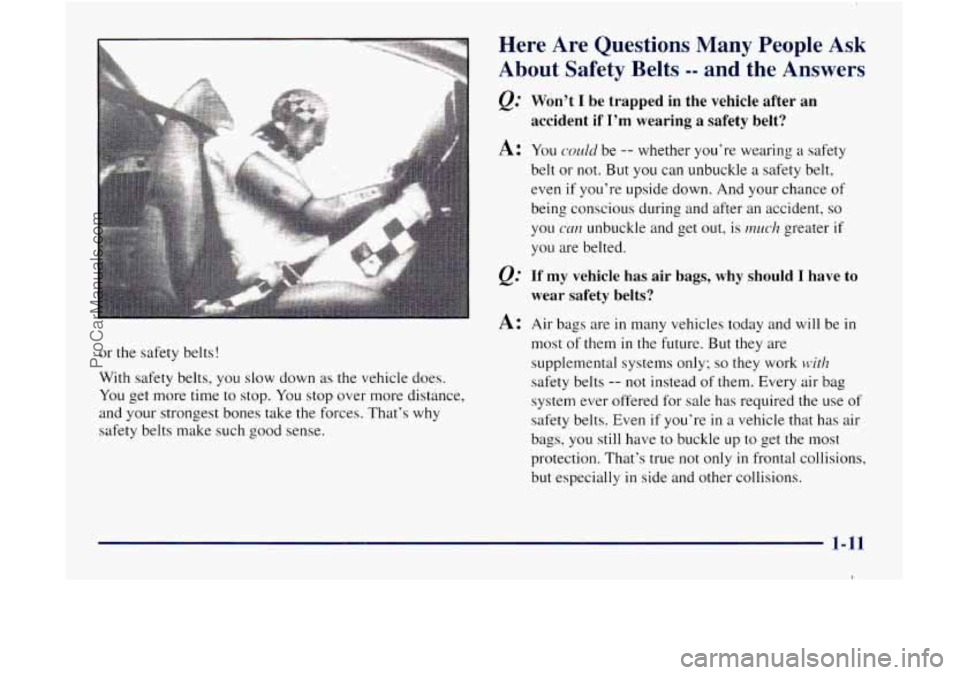
or the safety belts!
With safety belts, you slow down
as the vehicle does.
You get more time
to stop. You stop over more distance,
and your strongest bones take the forces. That's why
safety belts make such good sense.
Here Are Questions Many People Ask
About Safety Belts
-- and the Answers
&.. Won't I be trapped in the vehicle after an
accident if
I'm wearing a safety belt?
A: You ctxrld be -- whether you're wearing a safety
belt or not. But you can unbuckle a safety belt,
even if you're upside down. And your chance
of
being conscious during and after an accident, so
you car2 unbuckle and get out, is m~h greater if
you are belted.
Q.' If my vehicle has air bags, why should I have to
wear safety belts?
A: Air bags are in many vehicles today and will be in
most of them in the future. But they are
supplemental systems only;
so they work with
safety belts -- not instead of them. Every air bag
system ever offered for sale has required the use of
safety belts. Even if you're in a vehicle that has air
bags,
you still have to buckle up to get the most
protection. That's true not only
in frontal collisions,
but especially
in side and other collisions.
ProCarManuals.com
Page 19 of 386

@ If I’m a good driver, and I never drive far from
home, why
should I wear safety belts?
A: You may be an excellent driver, but if you’re in an
accident -- even one that isn’t your fault -- you and
your passengers can be hurt. Being
a good driver
doesn’t protect you from things beyond your
control, such as bad drivers.
Most accidents occur within
25 miles (40 km) of
home. And the greatest number of serious injuries
and deaths occur at speeds of less than
40 mph
(65 km/h).
Safety belts are for everyone.
How to Wear Saf elts Properly
Adults
This part is only for people of adult size.
Be aware that there are special things to know about
safety belts and children. And there are different rules
for smaller children and babies.
If a child will be
riding
in your vehicle, see the part of this manual
called “Children.” Follow those rules for
everyone’s protection.
First, you’ll want
to know which restraint systems your
vehicle has.
We’ll start with the driver position.
Driver Position
This part describes the driver’s restraint system.
1-12
ProCarManuals.com
Page 20 of 386
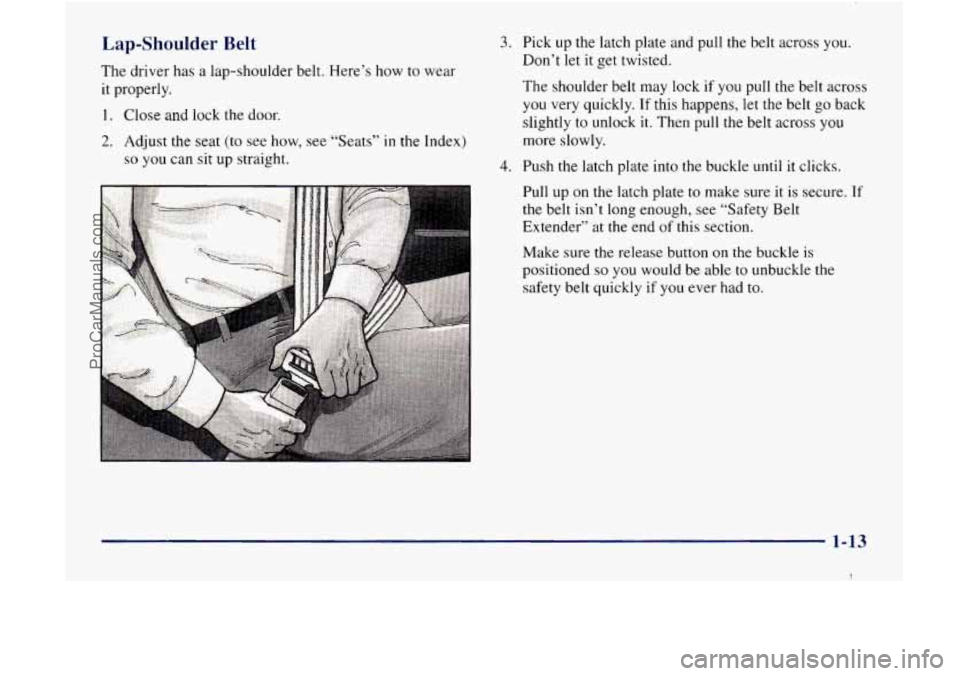
Lap-Shoulder Belt
The driver has a lap-shoulder belt. Here’s how to wear
it properly.
1. Close and lock the door.
2. Adjust the seat (to see how, see “Seats” in the Index)
so you can sit up straight.
3. Pick up the latch plate and pull the belt across you.
Don’t let it get twisted.
The shoulder belt may lock
if you pull the belt across
you very quickly. If this happens, let the belt
go back
slightly to unlock it. Then pull the belt across
you
more slowly.
4. Push the latch plate into the buckle until it clicks.
Pull up on
the latch plate to make sure it is secure. If
the belt isn’t long enough, see “Safety Belt
Extender’’ at the end
of this section.
Make sure the release button on the buckle is
positioned
so you would be able to unbuckle the
safety belt quickly if
you ever had to.
1-13
ProCarManuals.com